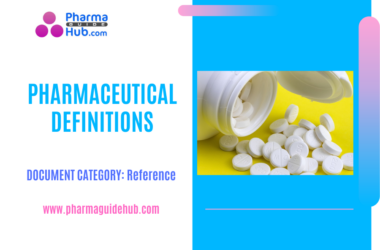Que 1: What is pH?
Ans: The pH is defined as the negative log10 of the hydrogen ion concentration expressed in mol/L. A negative logarithmic scale is used because the numbers are all less than 1, and vary over a wide range. Since the pH is the negative logarithm of the hydrogen ion concentration, low pH numbers, e.g. pH 6.2, indicate relatively high hydrogen ion concentrations, i.e. an acidic solution. High pH numbers, e.g. pH 7.8, represent lower hydrogen ion concentrations, i.e. alkaline solutions. Because the pH scale is logarithmic to the base 10, a 1-unit change in pH represents a 10-fold change in hydrogen ion concentration.
Que 2: What you get from Orange Book?
Ans: Innovator’s Leaflet, Patent Number, Patent Code & Exclusivity, RLD status.
Que 3: What is the definition of SOP?
Ans: SOPs are detailed written instructions for the operations routinely performed in the course of any activities associated with pharmaceutical manufacturing.
Or
A written, authorized procedure which gives instructions for performing operations not
necessarily specific to a given product/material , but of a more general nature the equipment preventive maintenance and cleaning; recall of products; purchasing; cleaning of premises and environmental control; sampling and inspection, etc.
Que4: What are the contents of the SOP?
Ans: Objective/Purpose, Scope, Responsibility, Accountability, Procedure, List of formats / Annexure, Abbreviations, Reference, Revision History
Que 5: Which information should master document carry on every page not just one of the
pages to meet GMP?
Ans: Page number, document reference number and authorizing signatures
Que 6: How many SOPs required for equipment and what are those?
Ans: Operation, Cleaning, Preventive maintenance/ Calibration, Sampling procedure
Que 7 : What is the Batch production and control record (BPCR)?
Ans: BPCR are prepared for each intermediate and API and include the complete information
relating to the completion of each significant step in the Batch production.
Que 8: What is the Master production & control record (MPCR)?
Ans: To ensure the uniformity from batch to batch, master production instructions for each
intermediate and API are prepared, dated and signed by one person, immediately checked,
dated and signed by a person in the quality unit.
Que 9: What is the content of the MPCR?
Ans:
- The name of the intermediate or API being manufactured and an identifying document reference code, if applicable.
- A complete list of raw materials and intermediates designated by names or codes sufficiently specific to identify any special quality characteristics.
- An accurate statement of the quantity or ratio of each raw material or intermediate to be used, including the unit of measure. Where the quantity is not fixed, the calculation for each batch size or rate of production should be included. Variations to quantities should be included where they are justified.
- The production location and major production equipment to be used.
- Detailed production instructions, including the:
Sequences to be followed
Ranges of process parameters to be used
sampling instructions and in-process controls with their acceptance criteria, where
appropriate.
time limits for completion of individual processing steps and/or the total process,
where appropriate
expected yield ranges at appropriate phases of processing or time
Where appropriate, special notations and precautions to be followed, or cross-references
to these
Que 10: What is the difference between intermediate and drug substance (API)?
Ans:
Intermediate: A material produced during steps of the processing of an API that undergoes
further molecular change or purifications before it become an API (Reference: ICH Q7A).
API: Any substance or mixture of substances intended to be used in the manufacturing of a
drug (medicinal) product and that when used in the production of a drug, becomes an API of
the drug product. Such substances are intended to furnish pharmacological activity or other
direct effect in the diagnosis, cure, mitigation, treatment or prevention of disease or to affect the structure & function of the body (Reference: ICH Q7A).


